Introducing Dr. Millennial
Bridging the generational gap in the physician workforce.
Obstetrics and Gynecology has undergone notable change in the last few decades: advancement in subspecialties, greater diversity in practitioners, liability, robotics, and much more. The healthcare industry overall is experiencing an historic transformation that is impacting many facets of medicine.
Patients’ expectations, communication, access to health information, and desire for transparency and accessibility are just a few of the many aspects that are different today than they were a short time ago.
In the midst of the proliferation of the Internet and related technologies, the Millennial generation emerged in the workforce, and according to the U.S. Bureau of Labor Statistics, Millennials will comprise 75% of employees by 2030.
Generational awareness and proactive adaptations are paramount to enhance relationships among providers and patients and to maximize the attributes of each respective workplace age group.
Understanding generations
Generations are defined as cohorts of people born in a span of roughly 15 to 20 years that are influenced and often characterized by the social, economic, and political events that occur during their formative years.
These experiences help to shape a common system of beliefs, attitudes, and values held prominently within each group. Generations are often named by pop culture and the media, however, the United States Census Bureau defined one generation, the Baby Boomers.
Figure 1: Generations by birth year

The current healthcare workforce is composed of members of the Silent Generation (born 1928-1945), Baby Boomers (1946-1964), Generation X (1965-1980), and Millennials (1981-1996).
Members of Generation Z (1997-2012) are just beginning to enter medical school and careers in healthcare (Figure 1).
Although each generation has stereotyped descriptors, it is important to acknowledge that individual members may not always demonstrate these characteristics or self-identify with their own generation, depending on unique cultural conditions and life experiences.
Figure 2 summarizes the characteristics, experiences, innovations, and workplace attitudes for each generation. Members of the Silent Generation were children of crisis; their formative years occurred during the Great Depression and World War II, and thus birth rates were the lowest of any generation.
The Silent Generation came of age in an era of great scarcity and austerity and are known to be hard-working rule-followers who value stability and avoid rocking the boat.
Figure 2: Generational Differences

Early in their careers, members were thought to be happy to have a secure job, even if it was not the most desirable, and loyally kept their noses to the grindstone. For many, this loyalty holds fast today.
Baby Boomers were born during social and political upheaval but were also raised during a period of economic prosperity. They are characterized as competitive and ambitious, and are high-achieving, goal-oriented employees.
Striving towards and realizing the American Dream was a priority for many. Baby Boomers live to work, and many continue to work beyond the typical retirement age due to the joy they find in their occupations.
Resourceful and self-sufficient, Generation X’ers were dubbed “latchkey kids”; both parents often worked outside the home, so members of this generation looked after themselves and their younger siblings.
Many saw their mother and father divorce and were raised in single-parent households. Having witnessed the workaholic approaches of their Silent Generation or Baby Boomer predecessors, Generation X’ers have a mantra of “work to live” and value a more flexible work environment.
Millennials are the first generation to have been immersed in digital technology early in life; many had computers in their classrooms and were natural adopters of electronic modes of communication.
Their parents tended to be protective and very involved; “helicopter” and “snowplow” parents are widely used descriptors. Millennials are the most educated of any generation; nearly 40% of millennials have a bachelor’s degree or higher, compared with 15% of the Silent Generation.1
Members of this cohort are marrying later, starting families later, and are the most racially and ethnically diverse generation in the history of the workforce.
More than any other generation, Millennials are in search of a work-life integration that grants both personal and professional fulfillment.
Communication/learning
From house calls to smartphones, communication among members of the healthcare team and with patients has varied widely over the last several decades. While members of the earlier generations may recall a time when house calls were not unheard of, the evolution of clinical productivity standards now demands that physicians from all generations embrace email and increasingly text messaging.
Even the telephone is quickly becoming obsolete as practitioners seek to both deliver and consume communication asynchronously, sending and receiving when time allows.
Millennials who came of age during the smart machine revolution, which began around the turn of the 21st century and is ongoing, strongly prefer and are hastening the adoption of more modern communication regimes.
Millennials often expect this type of communication to be the norm, and it is not uncommon for them, when joining a practice, to start a group text thread among partners that they use freely at all hours of the day and night.
Just as the lines of communication are being redrawn, perhaps more uncomfortable for some, the traditional clinical chains of command are being blurred by eager and confident members of later generations.
Dr. Wagoner is Assistant Professor of Obstetrics and Gynecology and Director, Clerkship in Obstetrics and Gynecology, Medical University of South Carolina, Charleston.

Years ago, it would have been improper for a medical student to address an attending by their first name, but some new attendings actually prefer and invite trainees to dismiss formalities. This type of disregard for hierarchy sends ripple effects throughout academic departments and practices that are tolerated differently based on organizational philosophy and cultural acceptance of change.
A side effect of the gradual dissolution of hierarchy may be an exaggeration of ambiguity in how trainees and colleagues of different generations perceive workplace mistreatment by both peers and superiors.
Team-based approaches to learning and problem solving have been hardwired into newer generations. While most can easily conjure images from childhood of a favorite teacher at the chalkboard espousing wisdom to the masses, Millennials experienced the beginning phases of an ongoing reformation of classroom teaching that more heavily emphasizes problem-based learning in peer groups.
Recognizing that collaboration in the healthcare workplace is natural and necessary, many medical schools have trended in this direction, as well.
This evolution of teaching and learning has broad implications for how generations of physicians relate and work together. Millennials, for example, may have learned to frequently seek out the opinions of various care-team members while earlier generations might have been trained to make decisions based more on their own understanding and experience.
Work-life integration
What is work and what is life? There are thousands of articles on work-life “balance,” “fit,” “blend,” and “integration.”
The ratios of time and energy spent on personal and professional endeavors may vary not only by generation but also depending on stage of life. The values of any one member of a generation may change as the milestone events of life unfold.
What remains constant, however, are the positive professional and personal benefits of sustained maintenance of self-care.
Many are familiar with pre-flight instructions that advise passengers to don their own oxygen masks before assisting others; if providers aren’t mentally and physically healthy themselves, how can anyone expect them to care for their patients effectively?
Just as generation and stage of life are important determinants of values, gender cannot be overlooked. Today, more than half of ob/gyns are women, and over 80% of medical students who match into the specialty are female.2
Compare these numbers to 1970 when 93% of ob/gyns were men. And in 1970, many male physicians were not also responsible for caregiving and domestic duties. Women in medicine are almost twice as likely as men to have partners who are employed full-time (86% of females versus 45% of males).
Females in medicine with partners and children reported spending an average of 8.5 hours more on parenting and domestic tasks than their male counterparts each week.3
Physicians feel they are being asked to do more with less. There never seem to be enough hours in the day to complete work responsibilities, let alone adequate time for family and pleasure.
And while it may be easy for some to dismiss these sentiments as an insufficient work ethic in younger generations, one must carefully consider the disruptive transformation of modern healthcare delivery that is significantly influencing the dynamics of work-life integration.
Volumes could be devoted to an exploration of how this topic impacts other vital industries just as acutely as medicine, but take for example the mass exodus of teachers from the K-12 education arena. Only in recent history have regulations led to a demand for student recordkeeping so burdensome that the careers of many educators are extinguished prematurely.
The original meaning many teachers sought from a profession once regarded as a cornerstone of our society is being increasingly eroded, and this is a refrain that sounds all too familiar to many physicians today.
Whether symptoms of burnout have actually increased dramatically, or there is now more attention called to exhaustion, or both, job flexibility that allows for some work-life integration is highly valued, especially by younger generations. This begs the question: Is it possible to achieve work-life balance as a physician?
Understandably, there will be less of a balance and more of a blend as an ob/gyn, but creative solutions are imperative to ensure the feasibility of fulfilling both home and work responsibilities, within reason.
Further, these adaptations play a critical role in preventing exacerbation of the upcoming physician shortage by doctors who don’t maximize their career potential and instead retire early, decrease to part-time or less, or even change careers.4
One would assume that shifting careers from a physician to a different profession was previously unlikely, but Millennials and likely future generations perceive their careers to be less defining of their identities. As mentioned, professional and personal fulfillment are highly regarded by Millennials.
As such, opportunities to develop hobbies, devote time to family and friends, and volunteer in the local community and beyond will need to be recognized and supported by employers to ensure satisfaction and stability in the workforce.
A generational divide may seem inevitable; however, gaps can be narrowed with effort.
Strategies for compatibility
A generational divide may seem inevitable; however, gaps can be narrowed with effort.
Mentorship
Employers and organizations that provide support in the way of formalized mentoring programs will facilitate the dissemination of wisdom to newer generations and encourage goal setting. Clinical skills, productivity pearls, and expertise amassed through decades of practice are invaluable resources for junior partners.
Beyond these attributes, mentors may guide mentees by facilitating network connections and providing advice on promotion and career pathway optimization. Mentors serve as sounding boards during professionally challenging times or when difficult situations arise.
Reverse mentoring can occur in the same partnership; in this scenario the junior physician mentors the senior physician in unique skillsets they possess, especially adaptation to technology, which is second nature to Generation X and certainly to Millennials.
Reverse mentorship can offer mentees advice on electronic health record efficiency, template sharing, app utilization, website and social media presence, and more.
Formal mentorships are excellent resources for physicians in every career stage. These relationships can be created in departments and practices, or through utilization of the American College of Obstetricians and Gynecologists Mentor Program, especially when local connections are more limited.
As mentors and mentees begin to exchange viewpoints and develop relationships, generational understanding is naturally achieved, reinforced, and enriched.
Offer flexibility
Opportunities forflexibility in scheduling can be employee-friendly and also patient-friendly. Consider offering evening or weekend office hours a few times per month, which are highly desirable to Millennial patients.
Members of younger generations may gladly exchange morning hours for evening hours on occasion, as this may afford the opportunity to be involved in school activities for their children or errand-running that is otherwise not possible with a traditional physician schedule.
Similarly, setting up a practice to offer and receive reimbursement for e-visits or video visits is another convenient way to efficiently deliver healthcare. This can allow for occasional windows of time to work outside of the traditional office setting or even from home.
Though Obstetrics and Gynecology may be more limited than specialties such as Psychiatry in the visit types that can be offered electronically, opportunities do exist and will become more commonplace as generational demand increases.
Laborist and gynecologic hospitalist models have increased patient safetyand can provide unique appeals of acute, inpatient medicine and defined shifts.5
Though these models lack the benefit of patient continuity, both junior and senior physicians, as well as many practices, find this to be an attractive alternative to relinquishing obstetric services earlier in a career than desired and can also increase productivity in the office.
Create collaborative environments
Encourage input from all generations when crafting new policies and procedures and in solving problems. Harnessing the creativity of the group is likely to yield different perspectives and invoke innovation. When meeting together, all generations will appreciate a clear agenda with defined and respected start and end times.
Consider whether an email or text thread would be just as effective and more efficient than face-to-face contact. Leaders should strive to acknowledge the attributes and perspectives of each generation to achieve harmony and optimize productivity.
As we strive to enhance our relationships with our colleagues and patients, it would benefit us all to consider the values, characteristics, and experiences of every generation.
With some effort, generational gaps can be narrowed and ob/gyns of all ages will thrive at home and at work and continue to deliver high-quality care to our patients.
__
References
- Bialik K, Fry R. Millennial life: How young adulthood today compares with prior generations. https://www.pewsocialtrends.org/essay/millennial-life-how-young-adulthood-today-compares-with-prior-generations/. Pew Research Center. February 14, 2019.
- Rayburn W. The Obstetrician-Gynecologist Workforce in the United States: Facts, Figures, and Implication. Washington, DC: ACOG; 2017.
- Jolly S, Griffith K, DeCastro R, Stewart A, Ubel P, Jagsi R. Gender differences in time spent on parenting and domestic responsibilities by high-achieving young physician-researchers. Ann Intern Med. 2014;160(5):344-353.
- Association of American Medical Colleges.New findings confirm predictions on physician shortage. https://www.aamc.org/news-insights/press-releases/new-findings-confirm-predictions-physician-shortage. August 23, 2019.
- ACOG Committee Opinion 459. The Obstetric and Gynecologic Hospitalist. Committee Opinion No. 459. American College of Obstetricians and Gynecologists. Obstet Gynecol. 2016;127:e81-e85.

S4E1: New RNA platform can predict pregnancy complications
February 11th 2022In this episode of Pap Talk, Contemporary OB/GYN® sat down with Maneesh Jain, CEO of Mirvie, and Michal Elovitz, MD, chief medical advisor at Mirvie, a new RNA platform that is able to predict pregnancy complications by revealing the biology of each pregnancy. They discussed recently published data regarding the platform's ability to predict preeclampsia and preterm birth.
Listen
